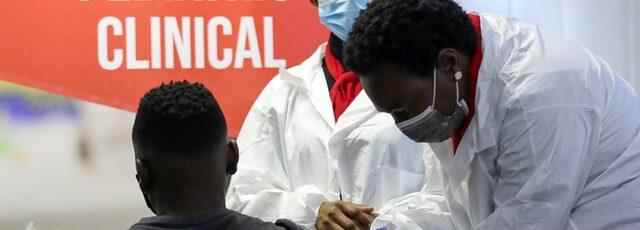Two years after announcing the first lockdown measures due to the coronavirus, daily life in the USA is gradually opening up to pre-pandemic conditions. So what about the situation in other parts of the world?
When the state of California ordered its citizens to “stay at home” on March 19, 2020, the majority thought life would return to normal relatively soon. But it didn’t.
After 24 months, as the coronavirus measures are gradually relaxed in the USA and many other countries, people are finally starting to see the light at the end of the tunnel.
But in some regions, the number of cases has reached record levels once again, and it seems that the end of the epidemic is not yet over.
We asked our correspondents in England, Hong Kong, South Africa, New Zealand, Canada, Peru and the USA to briefly describe the latest situation.
Cases are increasing, but measures are being lifted – Britain
*Nick Triggle, London*ra
At the end of February, the obligation to self-isolate those who test positive for Covid, which is the last legal obligation regarding Covid, was lifted in the UK.
A month ago, at the end of January, the government abolished the mask requirement in closed public places such as shops and public transport, and the recommendation to work from home where possible.
But to tell the truth, the UK has already preferred much lighter rules than many countries on Covid-related measures since last summer.
The mask requirement and the recommendation to work from home, which were removed months ago, were also reintroduced at the end of 2021 due to the wave of new cases caused by the Omicron variant.
The UK government’s approach is justified by the fact that 95 percent of the country’s most at-risk population over 60 now also have booster vaccines and the vaccines provide good protection.
Despite the large increase in the number of cases of the Omicron variant, the deaths caused by the disease do not seem to exceed the normal death rates in the winter months.
Although the numbers indicate that cases are starting to climb again, this does not seem to be of much concern at the moment.

Everything is as before, except the mask – South Africa
Pumza Fihlani, Johannesburg
In South Africa, everything seems to have largely gone back to the pre-pandemic era.
The government also lifted the night-time curfew and alcohol sales ban in December for the first time in two years.
(South Africa was one of the few countries to ban the sale of alcohol in 2020 at the height of the epidemic.)
Today, life seems to have returned to normal in various cities and towns of the country. The streets have become as crowded as before, people commute to work.
There is something that reminds us that Covid is still in our lives: it is mandatory to wear a mask in all public places and most people follow this rule.

According to official figures, after the fourth wave created by the Omicron variant, which started a few months ago, cases are on the decline again.
Most schools are open, but debate continues over whether to require vaccinations for workers in service sector organizations.
It is also unclear to what extent socialization is permissible. Nightclubs are still closed, but barbarians and taverns are open, and people will be able to socialize outside until late with the removal of the night curfew.

Many cases, few deaths – New Zeland
*Simon Atkinson, S*idney
My friend, who had lived in Tasman, Wellington for almost two years, didn’t really care about the outbreak.
This week, he sent an angry voicemail on WhatsApp: “Damned mad! We all got this goddamn Covid!”
With very tight closures and immediate complete isolation, the country was cited as a success story during the Covid epidemic. Now the number of cases is increasing rapidly.
And many New Zealanders still struggle to understand how their country could go from less than 1,000 cases a day to 20,000 cases a day in a matter of weeks.
Until recently, Prime Minister Jacinda Ardern still followed a policy of zero tolerance.

What is still comforting in the face of this psychological shock is that the total number of deaths from Covid has been below 120 since the very beginning of the epidemic. This is largely attributed to the fact that 95 percent of the population, excluding young children, have received their full dose of vaccinations.
Despite the increase in cases, some of the restrictions were still relied on, and the isolation conditions of Covid patients were eased.
However, in some sectors, legislation that meant those who refused to be vaccinated would lose their jobs were protested for three weeks in the capital, Wellington, and this rule still applies.
New Zealanders from abroad who have received two doses of the vaccine are now open to entering the country without going into quarantine or isolation. Considering that the borders have been closed for two years, this is a very important step.
People traveling to New Zealand from 60 countries, including the USA and the UK, will also have the same freedom, provided they present a negative test from 2 May.

So many cases, so many deaths – Hong Kong
Grace Tsoi, Hong Kong
The Omicron variant showed Hong Kong very clearly the dangers of the epidemic.
Hong Kong implements China’s “Zero Tolerance” policy against Covid. In this context, entrances to the country are subject to very strict control and very strict quarantine rules are applied. Thanks to this policy, the region was able to largely prevent the spread of the virus in the first two years of the epidemic. By the end of 2021, the total of all cases was only 12,000.
Hong Kong is the country with the highest coronavirus death rate in the world today. Most of the dead are unvaccinated and elderly patients. The number of people infected with the disease has exceeded half a million.
The virus is still spreading despite strict social distancing measures. Restaurants cannot serve food inside after 6 pm, and public places such as gyms and bars have been closed since January.
People have difficulty in understanding the policies followed in the face of the crisis and are angry.
Citing government sources, local media outlets cite the possibility of a city-wide shutdown and mandatory testing of the entire population of 7.4 million.
Panicked by such news, the people turned to shopping and the shelves of the markets were empty.
But Hong Kong’s leader, Carrie Lam, said this week that testing everyone is no longer a top priority.
This destructive wave will surely pass. Most of the population will either get sick and acquire natural immunity, or be vaccinated.
However, one cannot help but ask the question: Should Hong Kong still pursue its “Zero Tolerance” strategy as domestic companies run into great difficulty and international talent is starting to leave the city?

Eyes mostly on the political crisis – Peru
Katy Watson, Sao Paulo
Peru was one of the countries that was able to implement the fastest and most stringent lockdown measures after the Covid-19 outbreak began.
Strict curfews were declared. So much so that in the early stages of the epidemic, it was not even possible to walk a dog.
However, this still did not prevent Peru from being badly affected by the epidemic and the insufficient capacity of the hospitals.
In summary, the combination of people’s need to continue to work in this poor country, and the inadequacy and unpreparedness of public health services, resulted in the loss of many lives.

But two years later, things that seemed so scary at first seem to have become part of everyday life.
Restrictions are being lifted one by one and cases are still falling.
Of course, there are also reminders that the pandemic continues. Masks are still worn in many places and it is necessary to show a vaccination certificate to enter many places.
Still, we can say that Peruvians are probably more preoccupied with the political crisis in the country than with health problems at the moment.
President Pedro Castillo has formed his fourth government in the past seven months. His predecessor, Martin Vizcarra, was impeached in 2020.

Spring is coming, the ice is melting – F**mainland**
Robin Levinson King, Toronto
The arrival of spring brings the end of not only winter but also Covid restrictions in Canada this year.
Since most of the Covid rules are set by state governments, not the federal government, we can say that although the softening has not been fully implemented yet, relief has been seen in most places.
Any state or territory in the country that imposes a proof-of-vaccination requirement for indoor entry, such as restaurants, will lift this requirement by April. But the vaccination requirement will still apply to those working in some sectors, such as care work. Mask obligation is also removed, including schools.

According to decisions made by the federal government nationwide, it will still be necessary to wear a mask and show proof of vaccination when traveling by air and rail. Also, even though the government has begun to ease testing requirements for Canadian citizens, for now even those who have had all their vaccinations still have to be tested when entering the country.
These decisions were made after weeks of protests in the country’s capital against Covid measures, which led to the closure of one of Canada’s most important trade routes.
Decisions to ease the measures are not officially associated with the demonstrations, but some may see these steps taken by the federal government as a victory for the opposition or a concession by the government.
For a significant part of the pandemic period, Canada implemented very strict measures. Restaurants and gyms were kept closed for months in many cities, and vaccination passports were introduced when they opened.
Some Canadians wanted these measures to continue.
Although surveys show that most Canadians favor the end of restrictions, some individuals and businesses still choose to enforce the vaccination certificate and mask requirement. Therefore, we can say that for many, the epidemic period is still continuing.

Subways are packed again – USA
Tara McKelvey, Washington DC
Even seeing N95 masks, once prized accessories, just sitting there in their packaging at Georgetown University in Washington, is a sign that in the city and in the United States, rules are now allowing people to behave the way they used to.
Of course, some limitations persist to varying degrees depending on where you live, but the general picture is that freedoms are back.
In Texas and Florida, two states where the Republicans are dominant, the mask requirement has either been lifted or is very limited.
Even in states where Democrats are active and where strict mask rules were applied for a period, the bans were softened beyond the White House recommendations.
For example, in New York and New Jersey, masks are no longer required indoors. These policies largely reflect the public feeling more confident about the pandemic.

Although the USA still leads the countries with the most Covid deaths compared to the population, the number of daily cases has dropped from an incredible 800 thousand to 36 thousand.
There is also a 75 percent decrease in the number of hospitalizations.
As a result, according to Silicia Lomax, who works at a health policy consultancy in Washington, public morale is relatively high and people are starting to return to their normal daily lives.
Lomax points out that just a few months ago, there was a ghost town image on the subways, almost one person per car, but now public transport is getting crowded again.
